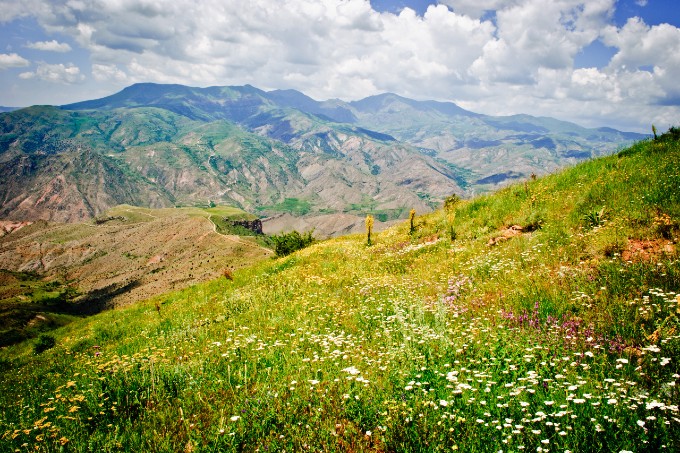Sustainable agriculture in Armenia
Nature conservation and sustainable regional development

Armenia is distinguished by ancient cultural landscapes and unique nature - photo: Laura Meinecke
Geography and agriculture
Armenia is a small, mountainous country in the South Caucasus, between Iran, Azerbaijan, Georgia and Turkey. The vegetation ranges from semi-deserts and grass steppes, to forested areas, subalpine tall forb stands and alpine meadows in the mountains, to swampland.
Alongside this richly diverse nature, Armenia's landscapes have long been influenced by human culture. Thousands of years ago, early civilisations had already begun to cultivate crops in the fertile regions, and agriculture continues to shape the appearance of the land through the present day: over 70 percent of the acreage is used as fields or grazing pastures.
In many places, the small-scale agriculture that remains in practice through today has favoured animal and plant diversity. One noteworthy aspect is the multitude of wild-type grain varieties and other crops, that have been retained here to date. The Armenian South Caucasus is home to one of the world's 36 biodiversity hotspots – these are particularly biodiverse and critically threatened regions around the globe.

Map of Armenia - graphic: freeworldmaps.net
Challenges in times of climate change

High mountains, steppes, lakes, semi-deserts, forests: Armenia offers natural diversity matched by few other countries on earth - photo: Володимир Гончарук - stock.adobe.com
The population is heavily dependent on natural resources. The use-based pressure on natural resources like water, forest and grazing land is accordingly high. This threatens Armenia's natural treasures. Illegal hunting, uncontrolled logging and overgrazing all endanger local biodiversity. Inadequate waste management, soil erosion, pollution and overuse of bodies of water also number among the country's gravest environmental problems.
Rising temperatures and dwindling precipitation as a consequence of climate change further worsen the availability of resources. The capacities of local small-scale farmers to adapt to climate-related changes in resource availability are limited due to their economic situation.
The creation of nature-friendly sources of income and an adaptation of land usage in response to climate change can contribute to the reduction of usage pressures on natural resources and can also improve the farmers' quality of life.
Our vision: Sustainable agriculture in Armenia

The “Mountain Tea” collection is the result of a collaborate effort between NABU, TeeGschwendner, and their Armenian supplier - photo: Hayk Babayan
Sustainable land use and organic agriculture are therefore essential components of the Armenian approach to sustainable development. Government policy on agriculture and nutrition aims to reverse environmental destruction, retain natural capital, ameliorate climate change and ensure inclusive economic growth. Climatic conditions in Armenia are just about ideal for the cultivation of wild herbs, fruit, berries and legumes, especially in mountainous regions unsuitable for other agricultural activities.
NABU supports Armenian farmers in converting their operations to organic agriculture and obtaining corresponding certification, as well as in the marketing of their products. For instance, NABU assists with brand design, setting up online shops and participating in international organic trade fairs (such as BIOFACH). The goal is a sustainable agricultural sector that contributes to the protection of important habitats. Beneficiaries of these policies include the wild relatives of many crops like pistachioes, apricots and wine grapes, which are part of Armenia's unique agrobiodiversity.
Working in concert with Armenian ministries and local partner organisations, NABU strives to win over as many local agricultural businesses as possible to the cause of preserving biodiversity, and in turn to offer them ease of access to organic producers, national and international markets.
Our partners and successes
As the aforementioned approach is particularly well-suited to strategically and sustainably supporting small-scale farmers in remote mountain regions, NABU's projects receive funding from partners such as the German Federal Ministry for Economic Cooperation and Development (BMZ).
Another important partner is the Armenian-French cooperative bank ACBA-CREDIT AGRICOLE. Because: The switch to organic farming means that farmers have to do without pesticides and chemicals. This costs farmers a good deal of money in the beginning. So that the move can still be financially attractive, the bank helps with tailored loans. The first funding programmes for organic agriculture in cooperation with ACBA-CREDIT AGRICOLE BANK were established as early as 2015.
The BMZ-funded project “Community-based Conservation and Adaptation to Climate Change in the Syunik Region” continues to run through 2024. The goal: building long-term capacity of the populations of 36 mountain villages in southern Armenia to sustainably implement organic agriculture. The project also serves as a model for the creation of nature-friendly sources of income, which in turn secure the livelihoods of the local population into the future. Factors relating to climate change are a particular focus of the project.
Past experiences from a comparable pilot project in northern Armenia (2019 through 2022, likewise funded by the BMZ) also served to inform the ongoing project work in southern Armenia.
MORE INFORMATION
The variegated landscapes of the Caucasus make it one of the world’s 36 biodiversity hotspots. NABU has been active in the Caucasus since the 1990s, when we took action to save the Caucasian wisent from extinction. Today, our work is focused on environmental education, sustainable development and the protection of other endangered species. more →
The mountains of Armenia belong to the Caucasus biodiversity hotspot and are unique in both natural and cultural heritage. With the project "Creative Mountains", NABU and its partners seek to promote conservation and sustainable development in local communities. more →
How can we incorporate environmental protection in our lives? The project Clean Future in Armenia pursues this question and answers it with collaborative action. To mobilise civil society against pollution – this is the goal of the project. For a clean future! more →



